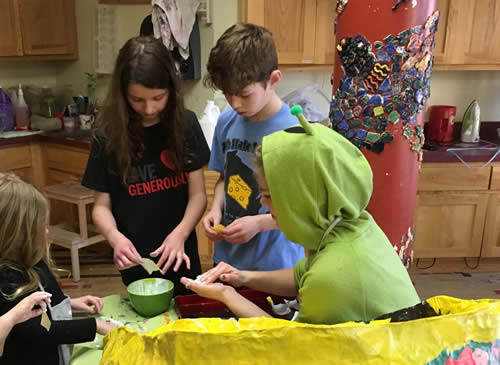During a recent visit to our elementary art classroom, I saw students in various stages of their personal learning projects. Some were heavily engaged in their work within the medium of their choice, such as sculpture or fiber arts. Others were capturing their work using the app Seesaw to showcase and self-assess their learning. The teacher was busy but not as we typically imagine: checking in on student progress, offering feedback on their process, and ensuring students were submitting artifacts of their work that truly represented their best efforts.
When she saw me, the school principal, she surprised me by apologizing. “Sorry for the mess. I realize it’s a little chaotic in here.”
I replied that it was not necessary to apologize. “Students have choice and voice,” I told her. “They are becoming self-directed learners because you are guiding them to assess their own work. Your kids are fortunate to be in your classroom!” She smiled with a sigh of relief and then continued with instruction.
This shift in instruction, with students in the lead, is not like flipping a switch. Technologies are popping up everywhere that promise personalized learning through digital portfolio assessment, in which students showcase and assess their work and then post it online for an authentic audience. But the actual practice of maintaining and communicating one’s learning involves more than adopting a tool.
So before diving into this work with you students, consider the following four points for ensuring this work is done with authenticity as well as for impact.
1. Portfolio assessment is not new to education.
Digital portfolios came into prominence in the 1990s, around the time when computers became commonplace in classrooms. David Niguidula, a pioneer in this alternative form of assessment, coined the term “digital student portfolios.” He defines them as “an online collection of student work for a particular purpose and audience.” Digital portfolios cut the distance between student thinking and evidence of learning. There is no longer a need to represent understanding through a score or a grade.
So why haven’t digital portfolios taken hold everywhere? Possibly because innovation is more about changing our practices and less about adding tools or technology. Karen Fadum, a former primary teacher and now helping teacher in British Columbia, Canada, uses FreshGrade to document her reading conferences with her young students. She records their conversations and posts them online for families to hear. Fadum says that when parents listen to these recorded conferences, they start to emulate her language when speaking with their child about their reading. Even better, her students grew as readers because of this double dose of responsive language.
Recording audio of a reading conference isn’t new to education. What’s innovative is using today’s tools to make learning truly visible for students and their families.
2. The best digital portfolios are process oriented.
A myth in education is that we should only showcase student’s best artifacts of learning. We might think of an artist’s body of work when considering digital portfolios as an alternative assessment. Yet how did that artist get to a point of success? The development of their skills and talent didn’t just happen. Many mistakes, quiet reflection, and new pursuits of learning had to have occurred prior to mastery.
So, it would be logical to expect a student’s digital portfolio to be process oriented. This means that at every critical stage of learning, something is documented. Not everything is published, but there is reflection and context for the work that’s attached to the artifact. Families, peers, and the student themselves come to see that understanding does not come out of thin air. The result is an appreciation for the process of learning itself that is not dependent on an external evaluation.
3. It’s not a digital portfolio unless students are in charge.
We think we are “doing” digital portfolios when we have students post their work for an audience along with a reflection. But students must get to decide what goes in and stays out of their portfolio. That’s the whole point of this practice. If students cannot discern what is high- quality work vs. what is less than expected, then they do not understand the criteria for success.
In Lisa Snider’s high school journalism course in Oklahoma, students publishing their pieces on WordPress blogs. These sites serve to document their writing throughout the year for an authentic audience (peers, parents, community). Snider does not grade their blogs; she asks students to self-assess their body of work and provide a final evaluation. The student and Snider come to an agreement about this summative assessment, with the student leading the conversation.
4. Digital student portfolios are about more than just assessment.
The best digital portfolio processes do more than serve as an evaluation tool. They help the student develop a stronger sense of themselves as a learner and see their growth over time, such as through a series of drafts posted toward a final project and presentation. Students start to identify themselves as capable learners. If the digital portfolio has been maintained over several years, their progress is even more evident. This type of self-observation communicates one’s role as an agent of their own life journey due to the visual nature of assessment.
And isn’t that the ultimate goal of education? To develop individuals who can reflect on their actions and make changes for the betterment of themselves and those around them? I cannot think of a better reason to introduce digital student portfolios into the classroom.
- 4 ways to encourage play in education - April 25, 2024
- CoSN IT Leader Spotlight: Lisa Higgins - April 25, 2024
- It’s time to pay student teachers - April 25, 2024


